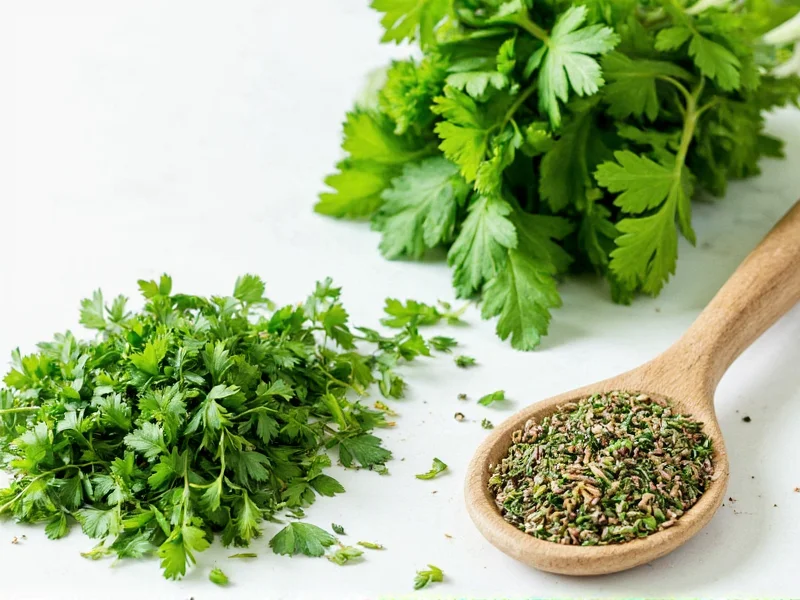When you're in the middle of cooking and realize your recipe calls for fresh parsley but you only have dried in your spice cabinet, knowing the precise conversion is essential for recipe success. This fundamental kitchen knowledge prevents flavor imbalances that can ruin otherwise perfect dishes. The difference between fresh and dried herbs isn't just about texture—it's a matter of chemical composition and water content that directly impacts your final result.
Why the 3:1 Ratio Works Scientifically
Understanding the science behind herb substitution helps you make informed decisions in the kitchen. Fresh parsley contains approximately 85% water, while dried parsley has most of this moisture removed through the dehydration process. This concentration means dried parsley packs three times more flavor compounds per volume than its fresh counterpart.
The drying process causes volatile oils like myristicin and apiol—key components of parsley's distinctive flavor—to become more concentrated. When rehydrated during cooking, these compounds release more slowly than fresh parsley's immediately available oils. This explains why adding dried herbs earlier in the cooking process often yields better results than adding them at the end.
Practical Conversion Guide for Real Kitchen Scenarios
While the basic 3:1 ratio serves as your foundation, different cooking applications require nuanced adjustments. Consider these factors when substituting in your recipes:
| Recipe Type | Fresh Parsley Amount | Dried Parsley Equivalent | Special Considerations |
|---|---|---|---|
| Salads & Garnishes | 2 tablespoons | 2 teaspoons | Avoid substitution when possible; fresh provides essential texture |
| Soups & Stews | 3 tablespoons | 1 tablespoon | Add dried parsley early to allow flavor development |
| Sauces & Dressings | 1 tablespoon | 1 teaspoon | Whisk dried parsley into warm base to activate flavors |
| Baked Goods | 1½ tablespoons | ½ tablespoon | Reduce by 25% as heat intensifies dried herb flavors |
When Substitution Requires Extra Attention
Certain dishes demand more careful consideration when swapping fresh for dried parsley. In delicate preparations like fish en papillote or fresh herb sauces, the texture difference becomes critical—dried parsley won't provide the same visual appeal or mouthfeel. For these applications, consider using freeze-dried parsley as a compromise, which rehydrates more completely than standard dried varieties.
Temperature plays a crucial role in substitution success. In high-heat applications like roasting or grilling, dried parsley's concentrated flavor holds up better than fresh, which can burn easily. Conversely, in cold applications like tabbouleh or herb butters, fresh parsley's bright flavor and texture are difficult to replicate with dried alternatives.
Maximizing Flavor from Dried Parsley
To get the most from your dried parsley substitution, try these professional techniques:
- Bloom in oil: Heat 1 teaspoon dried parsley in 1 tablespoon oil for 30 seconds before adding to dishes
- Rehydrate properly: Mix dried parsley with equal parts warm water and let sit for 10 minutes
- Layer flavors: Use 75% of calculated dried amount during cooking, then finish with remaining 25% at the end
- Store correctly: Keep dried parsley in an airtight container away from light to maintain potency for up to 6 months
Situations Where Substitution Isn't Recommended
While the fresh-to-dried parsley conversion works well in most cooked applications, certain dishes truly require fresh. Chimichurri sauce, gremolata, and Middle Eastern tabbouleh rely on fresh parsley's texture and bright, grassy notes that dried simply cannot replicate. In these cases, consider substituting with another fresh herb like cilantro or celery leaves rather than using dried parsley.
Expert Tips for Perfect Herb Substitutions
Seasoned chefs recommend keeping these principles in mind when substituting any fresh herb for dried:
- Always measure dried herbs with precision—a scant teaspoon differs significantly from a heaping one
- For long-cooking dishes, add only two-thirds of the calculated dried amount initially, then adjust at the end
- Combine dried parsley with a pinch of lemon zest to approximate fresh parsley's brightness
- When substituting in raw applications, mix dried parsley with finely minced celery leaves for better texture
Common Questions About Parsley Substitution
Can I use dried parsley instead of fresh in spaghetti sauce?
Yes, use one-third the amount of dried parsley compared to fresh. For spaghetti sauce, add dried parsley during the early simmering stage to allow flavors to develop fully. A good rule is 1 teaspoon dried for every 3 teaspoons fresh the recipe calls for, but reduce by 25% if the sauce cooks for more than 2 hours.
Does the quality of dried parsley affect substitution ratios?
Absolutely. High-quality dried parsley retains more volatile oils and requires less quantity. Test your dried parsley by rubbing a small amount between your fingers—if it releases a strong aroma, use the standard 3:1 ratio. If the aroma is weak, increase the dried amount by 25% to compensate for lost potency.
How do I substitute dried parsley in a dish that requires fresh as garnish?
For garnish applications, dried parsley isn't ideal due to texture differences. Instead, create a compromise by mixing ½ teaspoon dried parsley with 1 teaspoon finely minced celery leaves and a pinch of lemon zest. This combination mimics fresh parsley's appearance and provides similar flavor notes while maintaining some visual appeal.
Why does my dish taste bitter when I substitute dried parsley for fresh?
Bitterness typically occurs when using too much dried parsley or adding it too late in the cooking process. Dried herbs need time to rehydrate and release flavors gradually. If added at the end, they can taste dusty and bitter. Always use the 3:1 ratio as a starting point, add dried parsley early in cooking, and bloom it in a small amount of warm liquid before incorporating.











 浙公网安备
33010002000092号
浙公网安备
33010002000092号 浙B2-20120091-4
浙B2-20120091-4